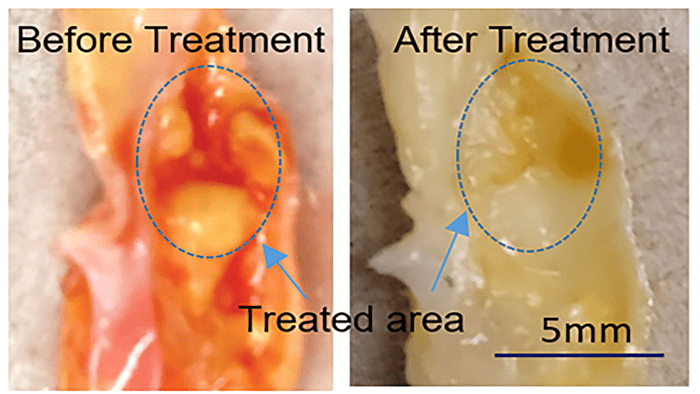
Researchers have developed a new technique comprised of a laser and ultrasound that “vaporizes” cholesterol plaques where they sit in the arteries. The new technology razes rather than compresses the fatty deposits that line the arteries due to a disease known as atherosclerosis. As such, the researchers believe the new method could stop plaques from reforming to become a total, non-reversible treatment.
The causes and treatment options for blocked arteries
Sometimes when you lead an unhealthy lifestyle, such as a bad diet, plaques or fatty deposits can start to stick to the inner walls of your arteries to cause a disease known as atherosclerosis. This condition, which is preventable using healthy interventions, basically involves the accumulation of plaques in the blood, made up of fat, cholesterol, cellular waste, calcium, and a blood-clotting material known as fibrin.
And as it’s asymptomatic in its early stages, you may not realize you have it. Eventually, though, as your arteries narrow further and harden due to bad lifestyle choices, the reduced blood flow and oxygen may cause chest pain (angina), breathlessness, coronary artery disease, a stroke, or even a heart attack.
Currently, no treatments can reverse narrowing arteries, only those that can stop it from worsening – such as lifestyle changes or medication. However, once the arteries have narrowed too much or a complete blockage has occurred, surgery is the only option with a balloon or stent traditionally used to expand the artery – compressing the plaque. But because these procedures do not entirely remove deposits, restenosis often occurs where the remaining plaque, roughened and abrasive, attracts more deposits from the blood to narrow the artery again.
Therefore, new techniques are desired with the ability to remove plaques altogether– leaving only the clean, smooth musculature of the artery in its wake. One such approach involves lasers capable of ‘vaporizing’ the cholesterol and gunk attached to the arterial walls in atherosclerosis. Still, these have exhibited a whole host of complications and haven’t worked that well because, historically, these methods have used high-power lasers, significantly impacting the system’s efficiency.
That was until a new study from researchers led by Rohit Singh and Professor Xinmai Yang at the University of Kansas demonstrated a method combining a low-power laser with ultrasound to remove plaque safely and efficiently.
In their abstract, the teams state: “In this study, we developed a novel technology that uses ultrasound along with laser to assist the removal of atherosclerotic plaque.” Expanding on their decision to add an ultrasound system, they said, “Our results show that the addition of ultrasound can effectively reduce the needed laser power, which could result in improved treatment safety and efficiency.”
How does the new ‘plaque vaporizer’ work?
Commonly, when high-power laser treatments apply heat to a liquid, they can lead to cavitation — a process whereby bubbles can form within the liquid due to a local reduction of pressure. These powerful bubbles occur at low-pressure regions, where liquids previously flowed at high velocities – as in this case, a blocked artery in the cardiac system. The ‘voids’ then expand and collapse to generate shockwaves to break up the plaque.
However, the new system is low-powered, creating laser pulses every nanosecond to produce far more accurately targeted microbubbles in more significant numbers than their high-powered counterparts. Additionally, the ultrasound causes the microbubbles to expand, collapse, and disrupt the plaque even quicker to produce a far more ergonomic system where not as much thermal energy is needed.
“In conventional laser angioplasty, a high laser power is required for the entire cavitation process, whereas in our technology, a lower laser power is only required for initiating the cavitation process,” Singh said in a statement. “Overall, the combination of ultrasound and laser reduces the need for laser power and improves the efficiency of atherosclerotic plaque removal.”
Initially, studies were first performed on pig belly fat samples to calibrate the ultrasound and laser. Once the scientists identified the optimal parameters, they used the system on plaque samples collected from patients during endarterectomy procedures, where surgeons cut into the narrowed artery to scrape away the plaques from its walls manually.
Results show that the new system destroys rather than compresses the plaque, promising a lower restenosis rate, as opposed to when surgeons use balloons or stents to clear and compress plaques in the arteries. The team stated that the control provided by their system should also lower the risk of damage to arteries.
However, the group can only state these claims firmly once studies are performed on live subjects to test the safety and efficacy of their new technique.
In his presentation, Rohit Singh will describe the group’s results: “A novel ultrasound-assisted laser technique to remove atherosclerotic plaques,” at the 182nd Meeting of the Acoustical Society of America at the Sheraton Denver Downtown Hotel.


